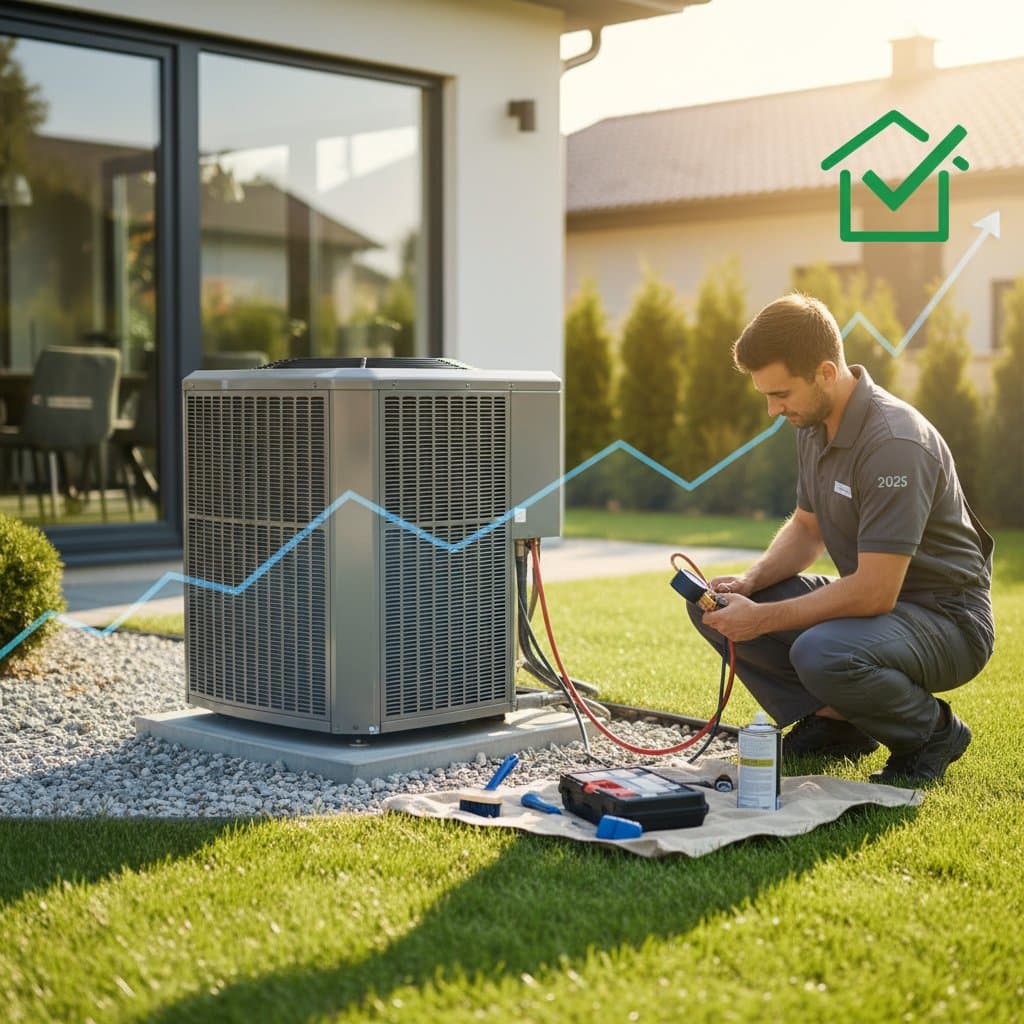Essential Preparation to Avoid AC Breakdowns During the 2025 Heat
Summer heat brings intense discomfort when an air conditioner fails unexpectedly. Homeowners often face such breakdowns at the height of the season, leading to elevated repair expenses and delayed service availability. Proactive maintenance measures significantly lower the chances of these disruptions and maintain a comfortable indoor environment amid extreme temperatures.
This guide outlines preparation strategies for air conditioning systems prior to the onset of heat. It provides a detailed maintenance checklist, insights into associated costs, and guidance on determining the need for professional assistance.
Homeowner Maintenance Checklist for AC Systems
A comprehensive pre-summer evaluation starts with straightforward tasks that most homeowners can perform without risk.
1. Replace or Clean the Air Filter
A clean air filter enhances airflow and reduces energy consumption. For disposable filters, replacement every one to three months is recommended. Washable filters require rinsing under running water and thorough drying prior to reinstallation. Neglecting this task allows dust accumulation within the system, which accelerates wear on vital components.
2. Clean the Outdoor Condenser Unit
The outdoor condenser requires unobstructed airflow for optimal operation. Clear leaves, grass clippings, and other debris from a two-foot radius around the unit. Employ a standard garden hose to rinse the fins, directing water from the inside toward the outside. Pressure washers should be avoided, as they may bend the delicate fins and impair efficiency.
3. Inspect and Straighten the Coils and Fins
Bent fins impede proper airflow through the system. A fin comb, purchasable at hardware stores for approximately ten dollars, straightens these fins with minimal effort. If the evaporator coil appears coated in grease or heavy grime, apply a specialized AC coil cleaner according to product instructions. Disconnect electrical power to the unit before any cleaning activities.
4. Examine the Condensate Drain Line
Blockages in the drain line result in water leakage indoors. Flush the line using a solution of warm water mixed with white vinegar to dissolve mineral deposits and algae. Should water continue to back up, attach a wet-dry vacuum to the drain outlet and suction until clear flow is restored.
5. Verify Thermostat Functionality
Set the thermostat to cooling mode and adjust the temperature setting several degrees below the current room temperature. The air conditioner should activate within one to two minutes. If no response occurs, inspect and replace thermostat batteries if necessary, and check the home's circuit breakers for tripped positions before considering technician involvement.
Cost Considerations and Potential Savings
Consistent maintenance alleviates stress on primary components, potentially decreasing energy usage by up to 15 percent, as noted in discussions among HVAC professionals. Cleaner coils and filters enable shorter cooling cycles, which lower electricity bills and prolong the lifespan of the compressor.
Failure to maintain the system may escalate minor issues into major repairs with substantial costs:
- Refrigerant leak repair: $200 to $600
- Capacitor or contactor replacement: $100 to $300
- Compressor replacement: $1,000 to $3,000
In contrast, preventive measures represent a worthwhile investment. Homeowners who adhere to routine tune-up schedules typically experience reduced emergency service needs and extended equipment longevity, often exceeding five additional years of service.
Diagnosing Typical AC Problems
Despite diligent maintenance, certain issues may arise under prolonged operation. Recognizing symptoms enables prompt action to limit further damage.
Warm air blowing from vents:
Low refrigerant levels, soiled coils, or a malfunctioning compressor serve as common culprits. Begin by verifying the air filter condition and thermostat configuration. If these elements check out, arrange for a professional diagnostic service.
Continuous operation of the unit:
An undersized system or refrigerant leakage frequently causes this behavior. Provide shade for the outdoor unit and enhance attic insulation to alleviate load, though expert evaluation remains essential for accurate resolution.
Water accumulation near the air handler:
Problems with the condensate drain or frozen evaporator coils are probable. Immediately shut off the unit to avert property damage and examine the drain line for obstructions.
Strange noises or vibrations:
Loose fan blades, deteriorated bearings, or electrical faults often produce rattling or humming sounds. Cease operation until a qualified technician conducts an inspection.
Strategies for Optimal AC Performance
- Maintain a detailed log recording filter replacements and professional service dates.
- Regularly trim shrubs and vegetation to preserve adequate airflow around the outdoor unit.
- Consider installing a smart thermostat, which tracks temperature fluctuations and sends diagnostic notifications via app.
- Integrate ceiling fans to circulate air, allowing higher thermostat settings without sacrificing comfort and reducing AC workload.
- Assess and upgrade attic insulation to minimize heat gain and retain cooled air within living spaces.
These modifications collectively diminish the cooling requirements, conserving energy while minimizing system strain.
Sustaining Long-Term AC Reliability
After completing initial cleaning and adjustments, ongoing vigilance ensures continued dependability. Establish calendar reminders for monthly filter checks and seasonal outdoor unit clearing.
Homeowners who prioritize regular air conditioner upkeep benefit from steady indoor comfort, reduced utility expenses, and diminished reliance on urgent repairs. By viewing the AC as a critical asset, consistent care yields reliable operation across every heatwave.
A straightforward checklist, dedicated time investment, and appropriate professional support distinguish a comfortable residence from an expensive crisis. Initiate preparations promptly to equip your air conditioning system for seamless performance against peak summer demands.





